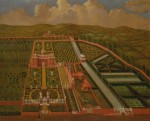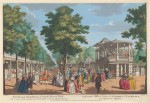From geometrically ordered flower beds and carefully shaped shrubs to irregular, supposedly “natural” winding paths, to chinoiserie-inspired oriental gardens, the eighteenth century saw a range of garden and landscape styles and theories.
Click Join Us if you would like to share work on eighteenth-century gardens and landscapes.
May 14, 2013
The physical garden was to Sir William Temple and other Epicureans a reflection of one’s mental landscape, and in the best of all possible worlds, one would stay in the garden–a position that Voltaire would later and more famously endorse in Candide. Like seventeenth-century definitions of wit, Temple’s philosophy of the garden expresses a balance of judgment and fancy, those gendered faculties of the mind, and an appropriate blend of reason and passion. The act of gardening for Temple was the practice of freeing the self from the disordered passions, unavoidable but capable of being subdued like wild weeds. One needs only a patch of earth, a shovel, and a life of the mind.
April 29, 2013
In many ways, pleasure gardens were the amusement parks of Georgian England, allowing visitors to escape the hustle and bustle of city life while offering them a variety of entertainment, including picturesque gardens, strolling paths, musical concerts, al fresco dining, balloon rides, waterfalls, fountain displays, masquerades, balls, and even fireworks shows.

